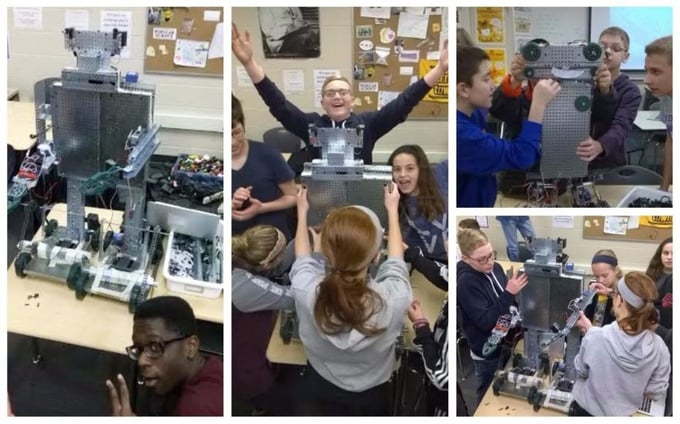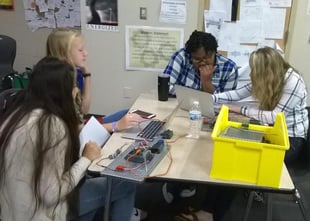Ross Hartley is a PLTW Gateway Automation and Robotics teacher at Pickerington Ridgeview STEM Junior High in Pickerington, Ohio.
Collaboration is one of the major skills I focus on challenging my PLTW Gateway Automation and Robotics students to build. Being able to work well with others to accomplish a shared goal is a skill that will not only help students in their educational career but also for the rest of their lives. This is not just an academic skill – it’s a life skill. And life skills are the base that academic skills are built on.
Three strategies that have proved successful with this type of group work learning environment are:
1. Creating groups of two to three students is ideal. Two students per group is best, three works well, and four students is too many. With four in a group, there is more of an opportunity for students to be off task and not focused on the challenge.
2. Purposefully selecting the groups. There are four different types of grouping I incorporate:
- Homogenous Groups: Group higher-level learners with other higher-level learners, medium-level learners with other medium-level learners, and so forth.
- Heterogeneous Mixed Groups: Group a higher-level learner with a medium-level learner, and so forth.
- Completely Random: Use a random computer generator to select the group members.
- Student Choice: Allow students to choose their group members.
3. Allowing groups to work at their own speed. As students solve one challenge, they are able to move on to the next challenge, whether other groups are done or not. For some groups, this allows more time to solve the problem at hand. And for others, it allows them to move onto the next problem to solve without having to wait on others.
To further build collaboration, the next level of group work evolves from groups of students working independently of each other, to all the groups working together for a united cause. I present a challenge to the whole class, and each group of students is in charge of a different piece of the solution. These different components are combined together to solve the proposed problem.
One challenge similar to this is the Assembly Line Challenge. The whole class takes on the task of creating an assembly line that produces widgets. Each group is in charge of a different component of creating the widget – drilling holes in the top, sanding the sides, painting, etc. The students then combine these different components together to form an assembly line that creates a widget! Students have to figure out what order to put the different elements in and get them to line up so that the widget passes from one job to the next.
Looking ahead, I see the next level of building collaboration as students determining the different roles/jobs for each group instead of me assigning them. In this situation, students have to figure out how to split up the project into different components. And then once they’ve determined roles, each group gets a job to complete. Once completed, these different components come together to solve the overall problem.
For example, I might tell students they have one week to build a life-size robot that can move forward and backward, open and close its hands, and show two different facial expressions. And with this, students have to figure out how to break down the robot so that each group is in charge of a different element.
I see the final level of building collaboration as students identifying and articulating their own problems and challenges for the whole class to solve. This is an opportunity to use a service-learning approach – students identify problems in their communities and then design and create solutions. Once they’ve identified the problem, students break the challenge down into different jobs for each group to complete. And once completed, the students combine these different parts to solve the problem at hand.
PLTW’s blog is intended to serve as a forum for ideas and perspectives from across our network. The opinions expressed are those of each guest author.


